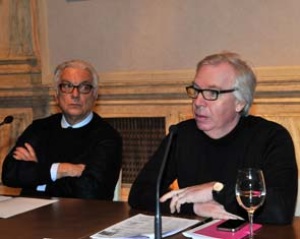Chipperfield announces Venice 2012 theme
On 17 January David Chipperfield, the director of the 2012 Venice Architecture Biennale, announced the theme of this year’s exhibition: Common Ground.
Chipperfield’s vision is for the Biennale to “celebrate a vital, interconnected architectural culture, and pose questions about the intellectual and physical territories that it shares.”

“In the methods of selection of participants,” he goes on, “my biennale will encourage the collaboration and dialogue that I believe is at the heart of architecture, and the title will also serve as a metaphor for architecture’s field of activity. I am interested in the things that architects share in common, from the conditions of the practice of architecture to the influences, collaborations, histories and affinities that frame and contextualize our work. I want to take the opportunity of the biennale to reinforce our understanding of architectural culture, and to emphasise the philosophical and practical continuities that define it.
“The title Common Ground also has a strong connotation of the ground between buildings, the spaces of the city. I want projects in the biennale to look seriously at the meanings of the spaces made by buildings: the political, social, and public realms of which architecture is a part …
“This theme is a deliberate act of resistance towards the image of architecture propagated in much of today’s media of projects springing fully formed from the minds of individual talents. I wish to promote the fact that architecture is internally connected, intellectually and practically, sharing common concerns, influences and intentions.”
David Chipperfield follows previous creative director Kazuyo Sejima, who Biennale president Paolo Baratta describes as having “brought the exhibition back into the hands of an architect” in 2010.
The theme announcement arrives months after the announcement of Australia’s 2012 entry to the Biennale: Formations. In a nod to the zeitgeist, the direction of the Australian entry by creative directors Anthony Burke and Gerard Reinmuth (in collaboration with TOKO) concurs with the aspirations of Chipperfield’s Common Ground. Via an open call, the Australian entry has assembled six architecture practices that are making collaborations to expand the field of architectural practice across Australia.
The UK and USA have also recently announced open calls of collaboration for their 2012 entries. The British entry, Venice Take-Away, is seeking ten architectural explorers to instigate global research projects with the hope of discovering ideas that can be transferred back to reinvigorate local practice. The US pavilion, Spontaneous Interventions: Design Actions for the Common Good, aims to document spatial tactics ranging from urban farms to guerilla bike lanes, temporary architecture, poster campaigns, urban navigation apps and crowdsourced city planning. The US entry follows the theme of two recent North American exhibitions focusing on architectural activism: the Canadian Centre of Architecture’s Actions: What You Can Do With the City of 2008/09 and New York MOMA’s 2010 exhibition Small Scale, Big Change: New Architectures of Social Engagement.
Over forty-one countries – including new additions Kuwait, Kosovo and Peru – will participate in the 2012 Venice Architecture Biennale held from 29 August to 25 November across the Giardini gardens, the Arsenale, and throughout Venice.









